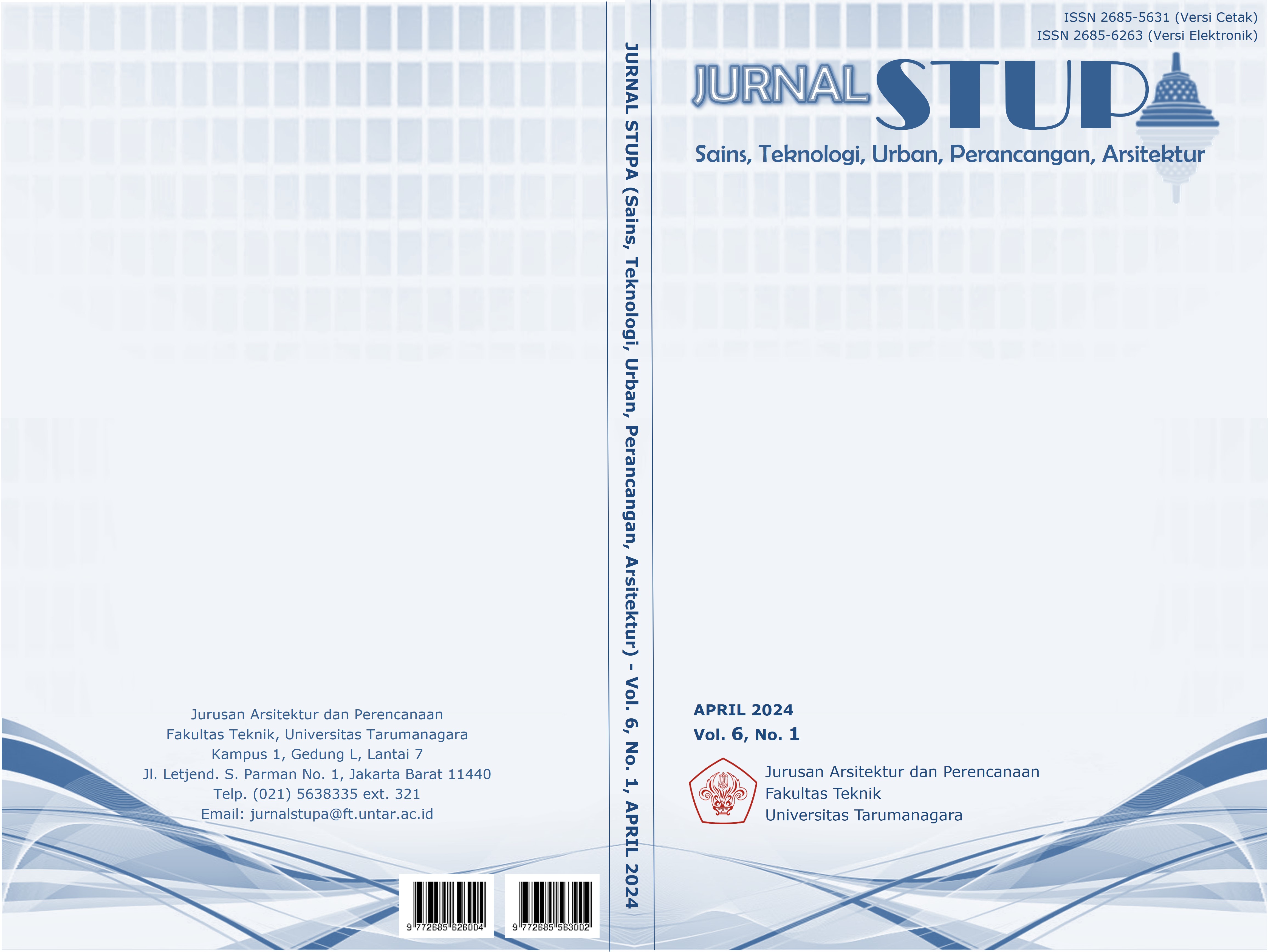MEMADUKAN DUNIA ANAK- ANAK MELALUI ARSITEKTUR BERMAIN: MERANCANG RUANG EDUKASI BERFOKUS SEJARAH PERMAINAN INDONESIA
Main Article Content
Abstract
In the face of rapid technological development, children's games have undergone significant transformation, leading to a decline in the physicality of play and the loss of the essence of play as a crucial aspect of child development. This study combines the Montessori approach, emphasizing the importance of play in developing sensory, motor, and social skills, with the concept of empathetic architecture. The focus is on redesigning playgrounds in two different locations: Cluster PIK2 and Kampung Lumpang. Through case studies, observations, and identification of children's needs, we have created design guidelines that integrate Indonesia's play heritage and empathetic architecture principles. The design program includes the redesign of playgrounds, art installations, and mural projects. Considering the needs of children in the local context, such as accessibility and the loss of the essence of street play, this design aims to rebuild physical, sensory, and social engagement through play. Through modularity and adaptation to the context of each location, this research unites the diversity of play spaces while respecting and preserving the history of Indonesian children's games, creating spaces that celebrate joy and the values of play in child development. The ultimate achievement of this design is the realization of a redesigned playground in a holistic and sustainable manner. Children in Kampung Lumpang and Cluster PIK2 can enjoy games that support the development of their sensory, motor, and social skills, while experiencing the joy and pride of Indonesia's play heritage. By involving them in the design process, this design also achieves the accomplishment of a shared sense of ownership within the community, creating strong social bonds and bringing together two potentially separate worlds.
Keywords: architecture empathy; montessori approach; play; playground
Abstrak
Dalam menghadapi era perkembangan teknologi yang pesat, permainan anak-anak mengalami transformasi yang signifikan, mengakibatkan penurunan fisikalitas permainan dan kehilangan esensi permainan sebagai aspek utama perkembangan anak-anak. Studi ini menggabungkan pendekatan Montessori, yang menekankan pentingnya permainan dalam pengembangan sensorik, motorik, dan keterampilan sosial, dengan konsep arsitektur empati. Fokusnya adalah merancang kembali taman bermain di dua lokasi berbeda: Cluster PIK2 dan Kampung Lumpang. Melalui studi kasus, observasi, dan identifikasi kebutuhan anak-anak, kami menciptakan panduan desain yang mengintegrasikan warisan bermain Indonesia dan prinsip-prinsip arsitektur empati. Program desain mencakup redesain taman bermain, instalasi seni, dan proyek mural. Dengan mempertimbangkan kebutuhan anak-anak dalam konteks lokal, seperti aksesibilitas dan kehilangan esensi bermain di jalanan, desain ini bertujuan untuk membangun kembali keterlibatan fisik, sensorik, dan interaksi sosial melalui permainan. Melalui modularitas dan adaptasi terhadap konteks setiap lokasi, penelitian ini menyatukan keberagaman ruang bermain dengan menghormati dan memelihara sejarah permainan anak-anak Indonesia, menciptakan ruang yang merayakan kegembiraan dan nilai-nilai bermain dalam perkembangan anak-anak. Pencapaian akhir dari desain ini adalah terwujudnya taman bermain yang dirancang ulang secara holistik dan berkesinambungan. Anak-anak di Kampung Lumpang dan Cluster PIK2 dapat menikmati permainan yang mendukung perkembangan sensorik, motorik, dan keterampilan sosial mereka, sambil merasakan kegembiraan dan kebanggaan akan warisan bermain Indonesia. Dengan melibatkan mereka dalam proses perancangan, desain ini juga mencapai pencapaian berupa rasa kepemilikan bersama dari komunitas, menciptakan ikatan sosial yang kuat dan menyatukan dua dunia yang mungkin terpisah.
Article Details

This work is licensed under a Creative Commons Attribution-NonCommercial-ShareAlike 4.0 International License.
This work is licensed under a Jurnal Sains, Teknologi, Urban, Perancangan, Arsitektur/ STUPA Creative Commons Attribution-NonCommercial-ShareAlike 4.0 International LicenseReferences
Carroll, N. (1985). Daedalus. The Power of Movies, Vol. 114(No. 4), 79-103. Retrieved from The : www.jstor.org/stable/20025011
Conti, G., Hansman, C., Heckman, J., Novak, M., Ruggiero, A., & Suomi, S. (2019). Socioeconomic background predicts individual differences in neurocognitive abilities. Developmental Science, 22(6), e12843. DOI: 10.1111/desc.12843.
Montessori, M. (1949). The Absorbent Mind. Henry Holt.
Montessori, M. (1967). The Discovery of the Child.
Montessori, M. (1972). Education for Human Development: Understanding Montessori. Schocken Books.
Putra, D., & Lukito, Y. N. (2018, Juni). Architect and Emphaty: The Importance of Human Experience in Architectural design. International Journal of Built Environment and Scientific Research, 2 (1), 47-54. doi:10.24853/ijbesr.2.1.47-54
Sardiana, K. (2018). Permainan Rakyat Tradisional di Indonesia. Prenada Media.
Sergei Ejzenštejn and Luigi Moretti. The Journal of Architecture, 1-19. doi:10.1080/13602365.2021.1958897
Smith, J., Brown, A., & Johnson, M. (2021). "The Impact of Physical Activity on Cognitive Development in Children." Journal of Pediatric Psychology, 46(5), 488–497. DOI: 10.1093/jpepsy/jsab007.Molinari, C. (2021). Sequences in architecture:
Zalewski, M., & Paszkowska, A. (2019). Empathic Architecture - Theoretical Background and Practical Consequences. Applied Sciences, 9(17), 3626. DOI: 10.3390/app9173626.Legg, T. J.



